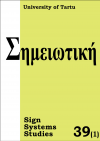Roman Jakobson and the birth of linguistic structuralism
Roman Jakobson and the birth of linguistic structuralism
Author(s): W. Keith PercivalSubject(s): Semiotics / Semiology
Published by: Tartu Ülikooli Kirjastus
Summary/Abstract: The term “structuralism” was introduced into linguistics by Roman Jakobson in the early days of the Linguistic Circle of Prague, founded in 1926. The cluster of ideas defended by Jakobson and his colleagues can be specified but differ considerably from the concept of structuralism as it has come to be understood more recently. That took place because from the 1930s on it became customary to equate structuralism with the ideas of Ferdinand de Saussure, as expounded in his posthumous Cours de linguistique générale (1916). It can be shown, however, that Jakobson’s group rejected Saussure’s theory for ideological reasons. As the term “structuralism” became more widely used it came to be associated with positivist approaches to linguistics rather than with the original phenomenological orientation that had characterized the Linguistic Circle of Prague. The purpose of this paper is to clarify these different approaches and to suggest that because of its extreme porosity the word “structuralism” is an example of a “terminological pandemic”. More research on the varied uses to which the key terms “structure” and “structuralism” were put will undoubtedly further elucidate this important episode in 20th-century intellectual history.
Journal: Σημειωτκή - Sign Systems Studies
- Issue Year: 39/2011
- Issue No: 1
- Page Range: 236-262
- Page Count: 27
- Language: English

